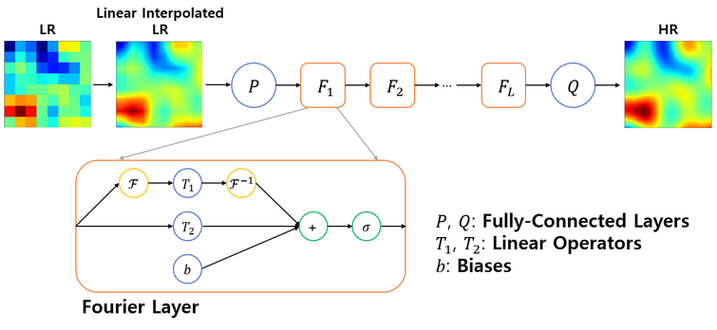Improving Diagnostic Accuracy of 4D Flow MRI with SOSVD Filtering
Center for Precision Medicine Platform Based on Smart Hemo-Dynamic Index
The Multiscale Heat & Fluid Flow Lab (MFL) utilizes 4D flow MRI to investigate complex flow phenomena in biological and engineering systems. While 4D flow MRI is a powerful modality for visualizing cardiovascular flows with complex geometries, its applications are often limited by measurement noise. To address this challenge, MFL has developed a novel denoising technique called the Split-and-Overlap Singular Value Decomposition (SOSVD) filter. Unlike conventional singular value decomposition methods, the SOSVD filter splits the velocity matrix into overlapping subdomains and performs SVD individually within each subdomain. By retaining only the dominant flow features—specifically the first singular mode—in each subdomain, this method effectively suppresses noise while maintaining physical fidelity. The SOSVD technique has been validated using both numerically simulated and experimentally acquired flow fields in a square duct, showing significant reductions in root mean square noise levels. Furthermore, its application to in vivo aortic flow data demonstrated substantial improvements in representative flow indices, including divergence, velocity gradients, streamline coherence, and overall flow consistency.
Human
Healthcare

Research Publication
1.
Patent
1.
S. Kang, D. An, H. Ha, D. Yang, I. Jang and S. Song, 2024, "Denoising four-dimensional flow magnetic resonance imaging data using a split-and-overlap approach via singular value decomposition", Physics of Fluids, 36, 011906
Noise Filter of 3D Velocity Field Data Using Singular Value Decomposition and Method of Noise Filtering Using the Same.
Patent No. 10-2845905, Patent Registration Date : 2025.08.08
Research Center & Sponsor
1.
2.
3.
Center for Precision Medicine Platform Based on Smart Hemo-Dynamic Index Research
National Research Foundation
Engineering Research Center
PINGS-X: Gaussian Splatting for Super-Resolution of 4D Flow MRI
Center for Precision Medicine Platform Based on Smart Hemo-Dynamic Index
The Multiscale Heat & Fluid Flow Lab (MFL), in collaboration with the Spatial AI Lab (SAIL), utilizes 4D flow MRI—a non-invasive modality that captures time-resolved blood flow velocity fields—to investigate complex hemodynamics. However, its clinical use is limited by long scan times and low spatial resolution. To address this, the team developed PINGS-X (Physics-Informed Normalized Gaussian Splatting with Axes Alignment), a novel super-resolution framework inspired by 3D Gaussian splatting in computer vision. PINGS-X represents flow using spatially aligned Gaussians, each encoding local velocity and pressure, and predicts values via normalized Gaussian-weighted summation. Gaussian splatting enables high computational efficiency, adaptive resolution, and fast convergence. Crucially, PINGS-X incorporates physical laws—continuity and Navier-Stokes equations—into its loss function, ensuring physically consistent reconstructions. Applied to synthetic and real 4D flow MRI data, PINGS-X achieves high-fidelity super-resolution, recovering fine-scale flow structures and reducing velocity error by over 50% compared to baseline methods, while significantly reducing training time.
Artificial
Intelligence
Human
Healthcare

Research Center & Sponsor
1.
2.
3.
4.
Center for Precision Medicine Platform Based on Smart Hemo-Dynamic Index Research
National Research Foundation
Engineering Research Center
Spatial AI Lab.
Integral parameters for hemodynamic analysis using 4D flow MRI
Center for Precision Medicine Platform Based on Smart Hemo-Dynamic Index
The Multiscale Heat & Fluid Flow Lab (MFL) is developing an integral parameter-based method to address the limitations of 4D Flow MRI caused by low spatial resolution. Conventional parameters such as wall shear stress (WSS) and oscillatory shear index (OSI) rely on spatial differentiation and are highly sensitive to noise, whereas the proposed integral parameters—time-averaged velocity magnitude (TA|V|) and oscillatory velocity index (OVI)—offer improved robustness and reliability. This method was validated using CFD simulations, in vitro 4D Flow MRI, and synthetic datasets. Even at reduced resolution, integral parameters maintained stronger agreement with CFD ground truth compared to traditional differential parameters. Empirical formulas were also established to estimate differential indices from integral values, enabling accurate prediction when direct calculation is unreliable. The approach has demonstrated strong potential for clinical application, offering a more stable and quantitative framework for hemodynamic analysis using 4D Flow MRI.
Human
Healthcare

Research Center & Sponsor
1.
2.
3.
Center for Precision Medicine Platform Based on Smart Hemo-Dynamic Index Research
National Research Foundation
Engineering Research Center
Fluid Dynamics of Veno-venous Extracorporeal Membrane Oxygenation Flow According to the Types of Femoral Drainage Cannulae
Center for Precision Medicine Platform Based on Smart Hemo-Dynamic Index
There are three configurations of cannulation for veno-venous extracorporeal membrane oxygenation (ECMO). Among them, the femoro-femoral dual cannulation is a commonly used option in the real clinical setting in terms of interventional reproducibility and economic feasibility. When performing femoro-femoral dual cannulation, multi-staged venous cannulae used for femoral drainage can provide lower recirculation rates and effective flows compared to conventional drainage cannulae. To our knowledge, however, there is no reported study regarding a comparison between the newly developed Bio-Medicus NexGen cannula and the multi-staged cannula. Theoretically, the former may reduce the recirculation compared to the latter, because its drainage parts can be kept away from the tip of the return cannula with sufficient drainage. Hence, we aim to compare the recirculation between the Bio-Medicus NexGen cannula and the multi-staged cannula for femoral drainage using computational flow dynamics.
Human
Healthcare

Research Center & Sponsor
1.
2.
3.
Center for Precision Medicine Platform Based on Smart Hemo-Dynamic Index Research
National Research Foundation
Engineering Research Center
Estimation Aorta Pressure Distribution Using Physics-Informed Neural Network
Center for Precision Medicine Platform Based on Smart Hemo-Dynamic Index
Pressure and wall shear stress constitute the dominant hemodynamic loads on the vascular endothelium but mapping the three‑dimensional intravascular pressure distribution remains difficult: direct measurement is invasive, and high‑fidelity CFD reconstructions, though reliable, demand hours to days of computational time. Physics‑informed neural networks (PINNs) offer a compelling alternative by embedding the Navier–Stokes equations into a deep‑learning framework, enabling near‑real‑time pressure predictions that are robust to noisy or sparse data, free from meshing overhead, and able to accommodate complex or patient‑specific boundary conditions. Leveraging these advantages, the Multiscale Heat & Fluid Flow Laboratory (MFL) is developing a PINN‑based model that ingests velocity measurements and instantly delivers spatially resolved pressure fields for patient‑specific vascular geometries, accelerating both research and clinical decision‑making
Artificial
Intelligence
Human
Healthcare

Research Center & Sponsor
1.
2.
3.
Center for Precision Medicine Platform Based on Smart Hemo-Dynamic Index Research
National Research Foundation
Engineering Research Center
Super-Resolution 4D Flow MRI data with Physics-Informed Neural Operator
Center for Precision Medicine Platform Based on Smart Hemo-Dynamic Index
The Multiscale Heat & Fluid Flow Lab(MFL) utilizes 4D flow MRI to investigate complex flow phenomena in biological and engineering systems. Although 4D Flow MRI can accurately measure three-dimensional flow fields, it has limitations in acquiring high spatial resolution data. To overcome this limitation, MFL developed a Super-Resolution Physics-Informed Neural Operator(SRPINO). High-resolution flow field data were down sampled to create low-resolution data, which were then used to train a model based on the Fourier Neural Operator (FNO) architecture. The model takes low-resolution input and outputs high-resolution flow field predictions. To ensure that the predicted high-resolution flow fields satisfy the conservation of mass, the model was trained with an additional constraint based on the continuity equation. Furthermore, to address FNO’s limitations with non-periodic data—due to its affinity for periodic functions—padding and Fourier continuation techniques were employed, enabling the model to generalize to more typical, non-periodic flow fields. Validation with randomly generated flow field data demonstrated that SRPINO can predict high-resolution outputs within few seconds.
Artificial
Intelligence
Human
Healthcare

Research Center & Sponsor
1.
2.
3.
Center for Precision Medicine Platform Based on Smart Hemo-Dynamic Index Research
National Research Foundation
Engineering Research Center
4D Flow MRI-based Blood Flow Visualization Software for physicians
Center for Precision Medicine Platform Based on Smart Hemo-Dynamic Index
The Multiscale Heat & Fluid Flow Lab (MFL) is currently developing software for cardiovascular disease diagnosis based on 4D-Flow MRI technology. The primary objective of this development is to create blood flow visualization software that can be easily used by medical professionals without specialized knowledge in fluid dynamics. This software aims to make sophisticated hemodynamic analysis accessible to healthcare providers, enabling them to utilize advanced flow analysis tools without requiring extensive background in fluid mechanics. To achieve this goal, we are developing CVFLOW, a comprehensive blood flow visualization software that simplifies complex hemodynamic analysis. CVFLOW incorporates the following key features: Automatic Vessel Segmentation from MRI, 3D Vessel Reconstruction, 4D-Flow MRI Velocity Field Analysis and 3D Velocity Field and Streamline Visualization. The ultimate goal of this research is to create an intuitive and user-friendly integrated solution for cardiovascular disease diagnosis based on 4D-Flow MRI that consolidates MFL's extensive hemodynamics research expertise. This comprehensive platform will serve as a unified tool that bridges advanced fluid dynamics research with practical clinical applications, enabling medical professionals to access sophisticated hemodynamic insights through an accessible and streamlined interface.
Human
Healthcare

Research Center & Sponsor
1.
2.
3.
Center for Precision Medicine Platform Based on Smart Hemo-Dynamic Index Research
National Research Foundation
Engineering Research Center







.png)
.png)
